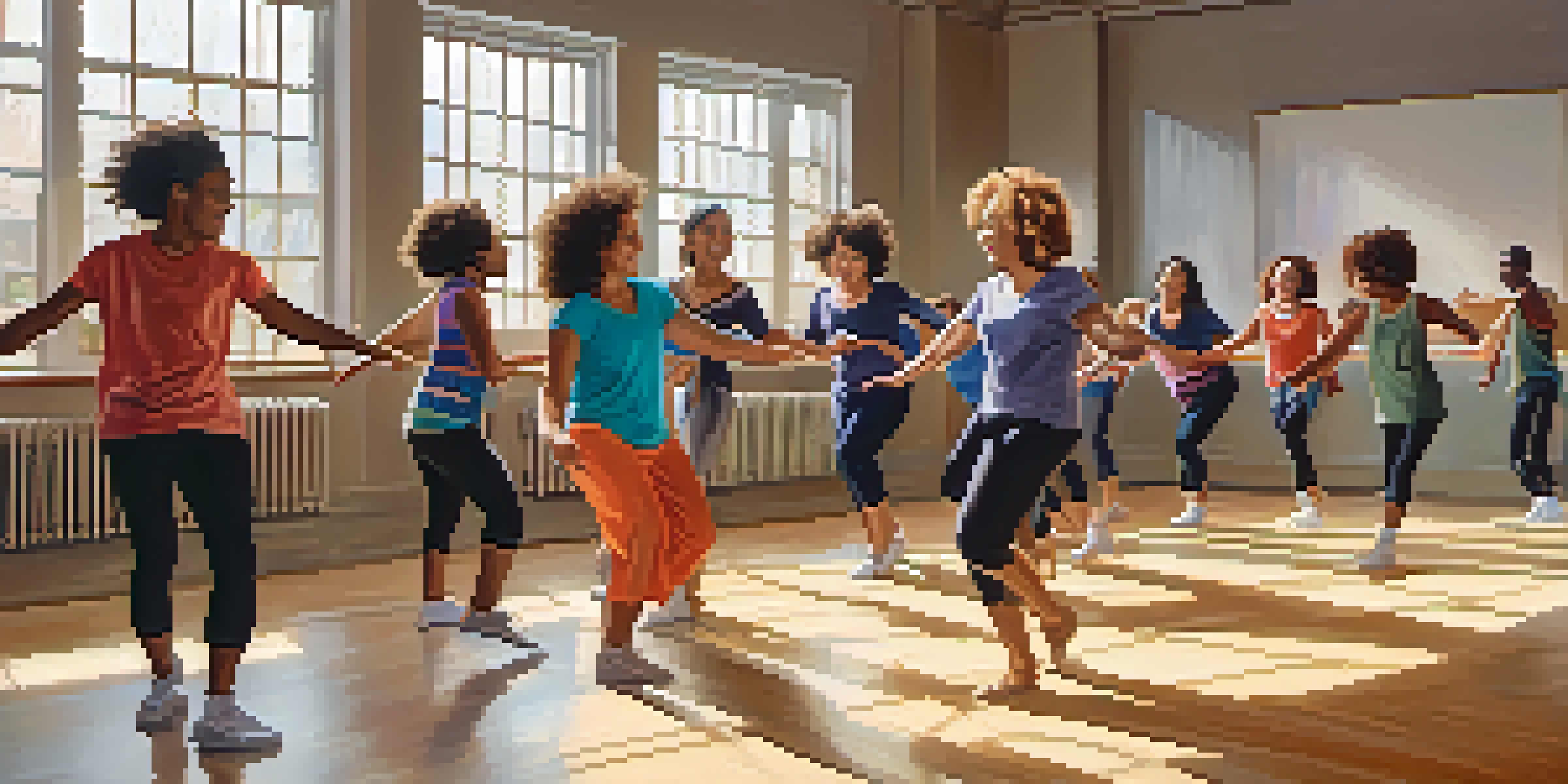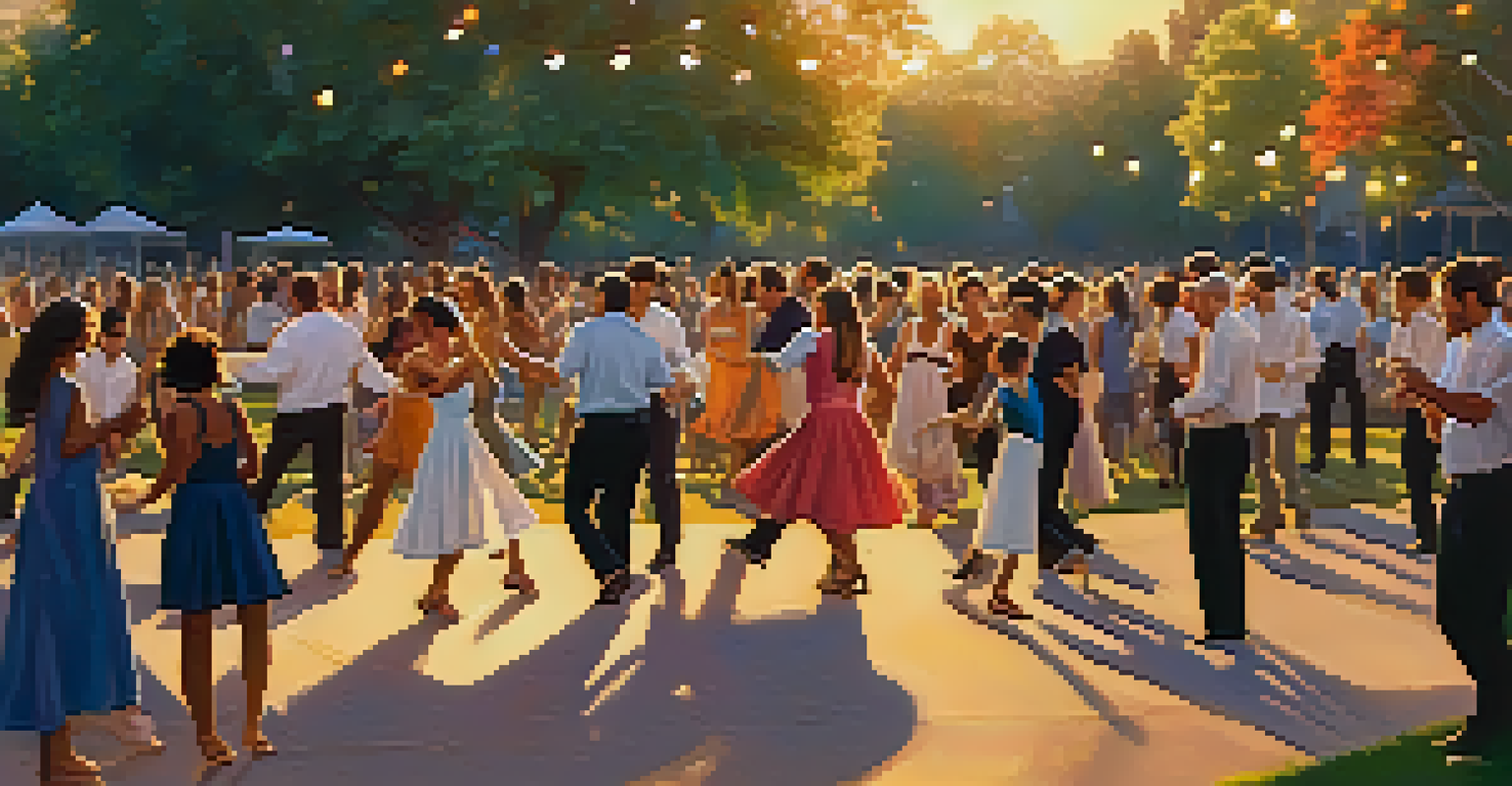The Impact of Group Dance on Loneliness and Isolation

Understanding Loneliness and Its Effects on Well-Being
Loneliness is more than just feeling alone; it's a profound emotional experience that can affect mental and physical health. It often leads to feelings of sadness, anxiety, and even depression. When individuals feel isolated, their overall quality of life diminishes, which can create a cycle that’s hard to break.
Dance is the hidden language of the soul.
In today’s fast-paced world, many people experience loneliness, regardless of their social circumstances. This can stem from factors like technology replacing face-to-face interactions or significant life changes, such as moving to a new city or losing a loved one. Understanding the root causes of loneliness is essential in finding effective solutions.
Research has shown that prolonged loneliness can lead to various health issues, including heart disease and a weakened immune system. Therefore, addressing loneliness is not just about improving emotional well-being; it’s also about enhancing physical health and overall quality of life.
The Power of Movement: Dance as a Social Connector
Dance has an extraordinary ability to bring people together. Whether it's a structured class or an informal gathering, moving in rhythm creates a shared experience that fosters connection. This can be especially powerful in group settings where individuals can bond over a common passion for dance.

When we dance, our bodies release endorphins, often referred to as 'feel-good' hormones. This physiological response boosts mood and encourages social interaction, making participants more likely to engage with one another. The joy of movement can create an upbeat atmosphere that diminishes feelings of isolation.
Loneliness Impacts Health and Well-Being
Prolonged loneliness can lead to serious mental and physical health issues, making it essential to address this emotional experience.
Moreover, dance can break down barriers, allowing individuals from diverse backgrounds to connect. It serves as a universal language, where the focus shifts from differences to shared enjoyment, creating a sense of community and belonging.
How Group Dance Classes Foster Community and Belonging
Group dance classes provide a structured environment where individuals can come together to learn and grow. These classes often encourage participants to support and motivate each other, creating a tight-knit community. This sense of belonging is crucial for those battling loneliness.
The only way to make sense out of change is to plunge into it, move with it, and join the dance.
As people attend classes regularly, they build relationships with fellow dancers, forming friendships that extend beyond the dance floor. These connections can lead to social outings, increasing social networks and reducing feelings of isolation. It's amazing how a shared interest can lead to lasting friendships.
Additionally, instructors often emphasize teamwork and collaboration in their classes, which further enhances the sense of community. When participants work together on choreography or support each other during practice, they create a positive and inclusive environment that nurtures friendships.
The Role of Dance in Enhancing Emotional Well-Being
Dance is not only a physical activity but also a powerful medium for emotional expression. It allows individuals to channel their feelings through movement, which can be cathartic and healing. This emotional release can help alleviate feelings of loneliness and isolation.
Engaging in dance can also foster self-esteem and confidence. As individuals learn new moves and improve their skills, they often feel a sense of accomplishment. This boost in confidence can encourage them to engage more socially, further combating feelings of loneliness.
Dance Builds Community and Connections
Group dance classes foster a sense of belonging, encouraging friendships that help combat feelings of isolation.
Moreover, dance offers a unique opportunity for mindfulness. Focusing on the rhythm and movements helps individuals stay present, reducing anxiety and promoting a sense of calm. This emotional grounding can be particularly beneficial for those struggling with loneliness.
Real-Life Stories: Transformative Experiences Through Dance
Many individuals have experienced transformative changes in their lives through group dance. For example, Sarah, a retiree, joined a local dance class hoping to stay active. Not only did she improve her physical health, but she also formed deep connections with her classmates, significantly reducing her feelings of loneliness.
Similarly, James, a newcomer to a city, found solace in a dance group that welcomed him with open arms. Through group performances and practices, he made lasting friendships that helped him feel more at home. His story highlights the powerful impact that dance can have on building community.
These anecdotes illustrate that dance can be a lifeline for those feeling isolated. The connections formed in these settings often provide the support and companionship individuals need to thrive socially and emotionally.
Dance as a Tool for Mental Health and Stress Relief
Engaging in group dance can serve as a vital tool for improving mental health. The combination of physical activity and social interaction provides a dual benefit, reducing stress and enhancing mood. This holistic approach makes it an excellent remedy for feelings of loneliness.
Studies have shown that regular participation in dance can lower levels of cortisol, the stress hormone, while simultaneously raising serotonin and dopamine levels, which are associated with happiness. This biochemical shift can lead to a more positive outlook on life and improved emotional resilience.
Dance Enhances Emotional Health
Engaging in dance provides a creative outlet for emotional expression, boosting mood and reducing anxiety.
Additionally, dance encourages creativity, which can be a powerful outlet for stress relief. When individuals express themselves through movement, they often find a sense of freedom that can help them cope with life's challenges, further alleviating feelings of isolation.
Conclusion: Embracing Dance to Combat Loneliness
In conclusion, group dance serves as a multifaceted solution to combat loneliness and isolation. It fosters community, enhances emotional well-being, and provides a creative outlet for expression. Through shared experiences and connections, dance creates an environment where individuals can thrive socially and emotionally.
As we continue to navigate a world where loneliness is prevalent, embracing activities like group dance can be incredibly beneficial. It not only encourages physical activity but also cultivates relationships that can last a lifetime.

So, whether you're a seasoned dancer or a complete beginner, consider joining a group dance class. You might just find that the rhythm of movement leads you to new friendships and a deeper sense of connection.